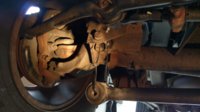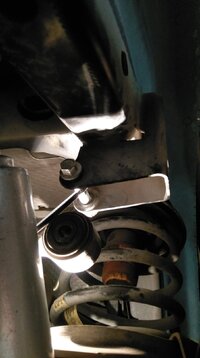If (assuming for now) the telegraphing of NVH is a real concern with the control arms, is it also a concern with the track bars? What might the ends look like? Should the design of the track bar be consistent with the design of the control arms?
With the pothole example, we've really been talking about Harshness. We should come back to the Noise and Vibration end of the scale at some point. We need to think about what happens when the suspension movements are high frequency, but low amplitude. But let's keep talking about track bars for now.
We know what the OEM track bars look like:


Those OEM bushings are a lot like the control arm bushings (Moog replacement, e.g.):
Could you do better? If the bushing is harder, the axle moves less horizontally, but we'd expect more NVH. If the bushing is softer, we'd expect more NVH. But steering response suffers if the bushings are too soft, because steering input and turning forces move the frame in relation to the axles more if the track bar bushings are softer.
But as we were discussing before, that's not necessarily the case with the control arm bushings. Control arms twist more than track bars do (except for the ball joint on the front track bar). And if the control arms can twist more freely, that could shift some of the suspension forces to other components that do a better job of controlling NVH.
If you look at the Currie front track bar, it has a Johnny Joint in place of the ball joint, but the same OEM type of bushing at the axle end. Presumably the Johnny Joint moves just as freely as the ball joint, but the Johnny Joint adds some extra isolation, because there's some PU around the joint where the OEM bar just has steel. So, maybe there's room for NVH improvement at the frame end of the front OEM track bar.



